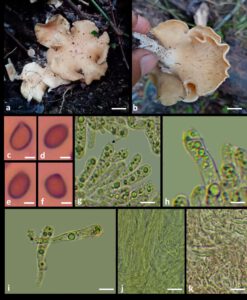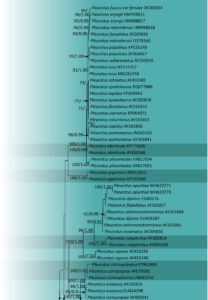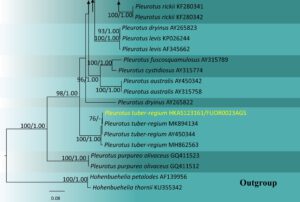Pleurotus tuber–regium (Fr.) Singer, Lilloa 22, 271 (1951) [1949]
Index Fungorum number: IF 303985, Facesoffungi number: FoF 13861; Fig. 1
Saprotrophic, solitary, growing on a buried decaying wood branch of a tree in moist humus soil. Basidiomata medium. Pileus 3–12 cm wide, infundibuliform, surface; yellow (2A7) to Pastel yellow (3A4) when young, mustard yellow (3B6) or citron (3B8) at maturity, fuliginous and minutely scurfy squamulose, not scaly. Margin incurved, tightly incurved and wavy at maturity, with small floccose fragments of the veil. Stipe 2–7 × 0.4–0.9 cm, central, sub-cylindrical to cylindrical, concolorous with the pileus, surface minutely scurfy squamulose. Lamellae deeply decurrent, heavily crowded, thin, narrow, 0.2–0.6 mm wide, dichotomous, pastel yellow (2A4) to subochraceous, with entire fuscous-grey edge, very sinuous on drying; no hyphal pegs. Context 1.3 mm thick in the centre of the pileus, at first cheesy and hard, then coriaceous, white. Odour mushroomy, taste; pleasant. Basidiospores 6.8–11 × 2.7–4.8 μm, brown in water and congo red, smooth, subcylindric to inamyloid, thin-walled. Basidia four spored, 20–37 × 3.7–8 μm, thin-walled, hyaline, granules present. Cheilocystidia 23–40 × 3.5–7.5 μm, subcylindric to subclavate, subventricose, projecting, elongated, thin-walled, hyaline, smooth, as a sterile edge. Pleurocystidia absent. Hyphae dimitic skeletal and generative hyphae present. Generative hyphae 2–7 μm, not inflating, thickened wall, frequently branching, clamp connections present. Skeletal hyphae 2–5 μm, hyaline, thickened wall, poorly branched. Gill-trama with radiate construction.
Material examined – Sri Lanka, Sabaragamuwa Province, Ratnapura District, on a buried decaying wood branch of a tree, 1 August 2021, D. Nimthara, HKAS123161/FUOR0023AGS.
GenBank accession number – ITS: OQ607414.
Known distribution (based on molecular data) – Australia, Chad Republic, India, Ivory Coast, Kenya, Liberia, Madagascar, Malaysia, Middle Congo, Nigeria, Papua New Guinea, Samoa, Sierra Leone, Solomon Islands, Sri Lanka, Tanzania, Thailand, Uganda, Zaire Republic, Zambia, Zanzibar, and Zimbabwe (Karunarathna et al. 2016, Readhead et al. 2021, Miriyagalla & Manamgoda 2022).
Known hosts (based on molecular data) – Daniellia spp. (Karunarathna et al. 2016, Miriyagalla & Manamgoda 2022).
Notes – Pleurotus is a common edible mushroom genus (Karunaratha et al. 2016). On a taxonomy basis, we introduce P. tuber-regium from Sri Lanka, which is closely related to records from Thailand (MK894134) and Papua New Guinea (AY450344). Morphologically, the new strain shares common macro and micro characteristics of P. tuber-regium recorded from China (Readhead et al. 2021), such as deeply infundibuliform pileus, scufsquamulosese surface and deeply decurrent, crowded lamellae while the new strain differs with 3 – 12 diam. of pileus, yellow, pastel yellow or mustard yellow surface, 68–11 × 2.7–4.8 µm of basidiospores, 20–37 × 3.7–8 of basidia and cheilocystidia of 23–40 × 3.5–7.5 µm. Pleurotus tuber-regium is well-recognized as an edible mushroom and has been reported from Sri Lanka in several studies on its edible value and cultivation potential. This study provides a new collection of P. tuber-regium with molecular data and a photo plate with a description from Sri Lanka.

Fig. 1 – Pleurotus tuber–regium (FUOR0023AGS). a, b Mature basidiome. c–f Basidiospores. g, h Basidia. i Cheilocystidia. j Generative hyphae. k Skeletal hyphae. Scale bars: a, b = 2 cm, c–f = 3 µm, g–k = 5 µm.

Fig. 2 – RAxML analysis based on the ITS sequence data of Pleurotus taxa. Forty-five strains are included in the phylogenetic analyses which comprised 1723 characters after alignment. Tree topology of the maximum likelihood analysis is similar to the Bayesian analysis. The best RaxML tree with a final likelihood value of -5553.639272. The matrix had 360 distinct alignment patterns, with 3.72% of undetermined characters or gaps. Evolutionary model applied for ITS is GTR+I+G. Bootstrap support values for ML equal to or greater than 65% and Bayesian posterior probabilities equal to or greater than 0.95 are indicated near the branches. Bootstrap support values for ML equal to or greater than 65%, and Bayesian posterior probabilities (BP) equal to or greater than 0.95 are indicated near the nodes. The tree is rooted with Hohenbuehelia petalodes (strain T-104) and Hohenbuehelia thornii (AMB 18086). Ex-type strains are in bold. The newly obtained strain is indicated in yellow.

Fig. 2 – Continued.
